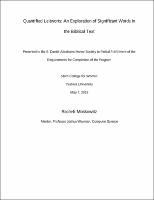Please use this identifier to cite or link to this item:
https://hdl.handle.net/20.500.12202/4497| Title: | Quantified Leitworts: An Exploration of Significant Words in the Biblical Text. |
| Authors: | Waxman, Joshua Moskowitz, Racheli |
| Keywords: | senior honors thesis Leitworts Textual analysis (Bible) Term frequency - Inverse Document Frequency (TF-IDF) |
| Issue Date: | 7-May-2019 |
| Publisher: | Stern College for Women Yeshiva University. |
| Citation: | Moskowitz, Racheli. Quantified Leitworts: An Exploration of Significant Words in the Biblical Text Presented to the S. Daniel Abrahams Honor Society in Partial Fulfillment of the Requirements for Completion of the Program Stern College for Women Yeshiva University. |
| Abstract: | Ben Bag Bag, a first century sage said of the Torah, “Search in it and search in it, since everything is in it.” (Avot 5: 25). The centuries-old field of biblical scholarship, especially of the Pentateuch, is unique in the focus placed on individual words. Endless commentaries both ancient and modern have been written expounding upon the use case and nature of “significant” words. Hidden meanings and messages may be contained in a single word of the text. This is a mindset that has existed since the ancient biblical interpreters whom, according to James Kugel, had a basic assumption that the text is a “fundamentally cryptic document”; that the text may appear to have one message but intend something else in its place or in addition (Kugel). The Talmud describes God constructing even tiny crowns upon the letters of the Torah, because the sage Rabbi Akiva would come in the future to interpret each and every letter, and expound endless laws from them (Babylonian Talmud, Menahot 29B). Then and now, the commentators mirror the description of the ancient Rabbi Akiva, often finding whole new underlying meanings constructed from significant words. In such a world of study, the question of what a “significant” word is, and what instances require absolute attention, is a vital one. Perhaps even more important, and difficult, is the question of some aspect of objectivity; asking whether determining significance in the biblical text can ever be approached in a more objective, quantifiable manner. This paper will seek to analyze and quantify a “significant” word, specifically within the highly analyzed, biblical text, based on common text analysis algorithms as well as methodologies of ancient and modern biblical commentators. This paper will explore three methods. 1) TF-IDF or term-frequency inverse document frequency, an algorithm well used in Natural Language Processing for giving weighted significance to terms in a document among a document corpus. 2) Leitwort style of exploring the text, the methodology classified by Martin Buber and Frank Rosenzweig in the early twentieth century (though with significantly earlier roots) which describes the biblical text as containing regularly repeating terms in a significant way to highlight ideas within the narrative. 3) A combination of these methodologies to be explored on the biblical text, using TF-IDF and leitwort techniques. Notably, each method is viewed here across several variations of the text. The Hebrew text and English translations of the text will both be used and analyzed in the code. Additionally, a modification of the Hebrew text based on the algorithm proposed by Shmidman, Koppel, and Porat will be used in the attempts to explore a more quantifiable version of the text. For all versions, the analysis of the text will be using the Judaic parshiot, as opposed to the Christian chapters. There are several outcomes sought for this paper. New methods of generating important words within such a highly analyzed text is a significant result in and of itself - these word instances are all worth exploring further and are perhaps key to drawing new conclusions of the text itself. In addition to a new collection of significant words within the text, perhaps a hierarchy of significance can also be determined. Words that overlap the given methods could arguably be even more significant, even more worthwhile to explore. Specifically, TF-IDF scores serve as an impressive insight to the topic words of the parsha. The leitwort, which is so strongly used to analyze the text for generations is also missing a measure of objectivity. Its ambiguity is something scholars who employ these methods note and critique (Grossman). Leitwort code here is significant in its attempts to quantify the process of determining a possible leitwort. The combination of TF-IDF and leitwort code also aims to create a new, objective method of attempting to find these leitworts, as opposed to the subjectivity in the current analysis that happens. |
| Description: | The file is restricted for YU community access only. |
| URI: | https://hdl.handle.net/20.500.12202/4497 https://ezproxy.yu.edu/login?url=https://repository.yu.edu/handle/20.500.12202/4497 |
| Appears in Collections: | S. Daniel Abraham Honors Student Theses |
Files in This Item:
| File | Description | Size | Format | |
|---|---|---|---|---|
| Racheli Moskowitz - Final thesis.pdf Restricted Access | The file is restricted for YU community access only. | 868.82 kB | Adobe PDF |  View/Open |
This item is licensed under a Creative Commons License

